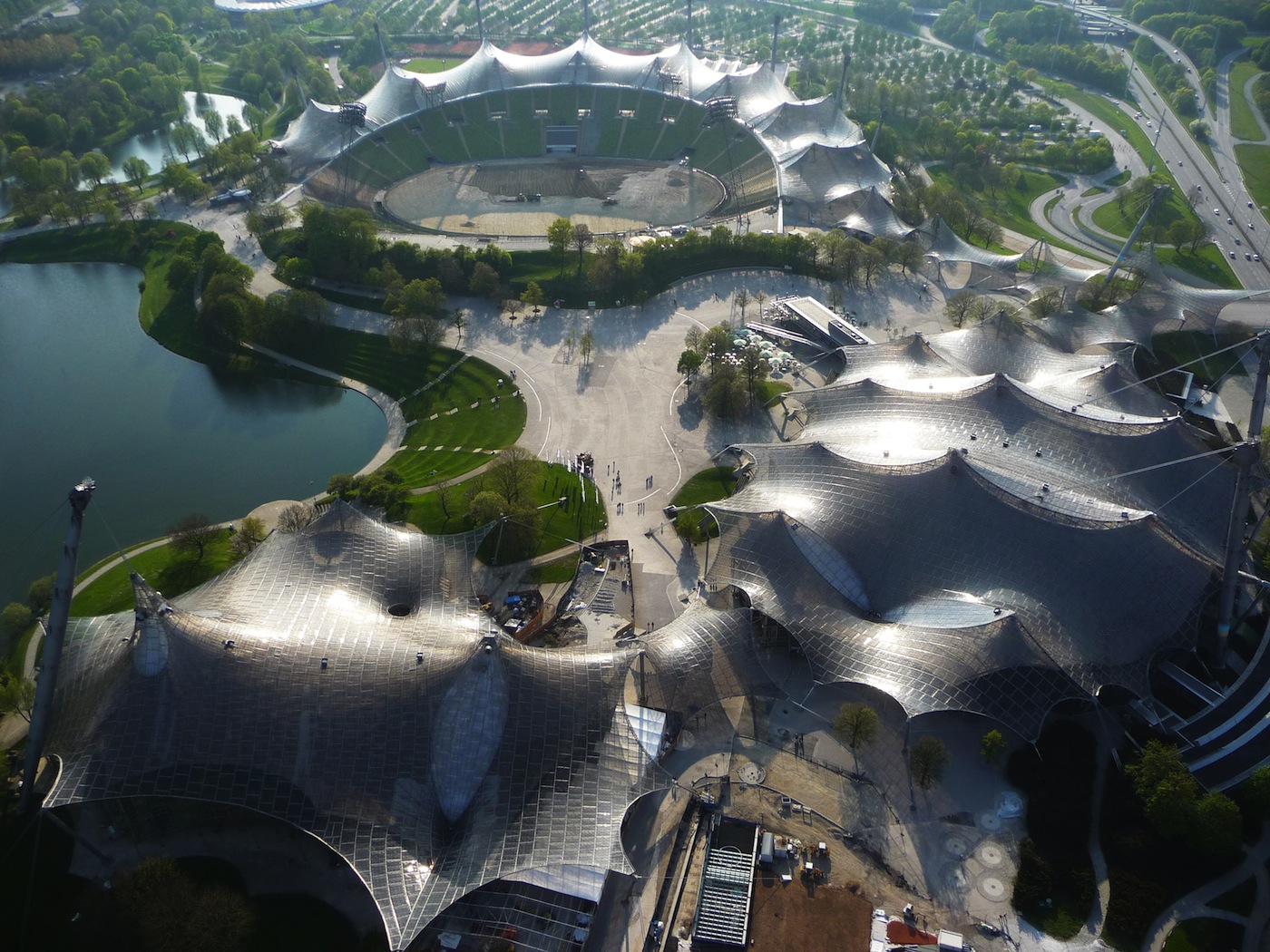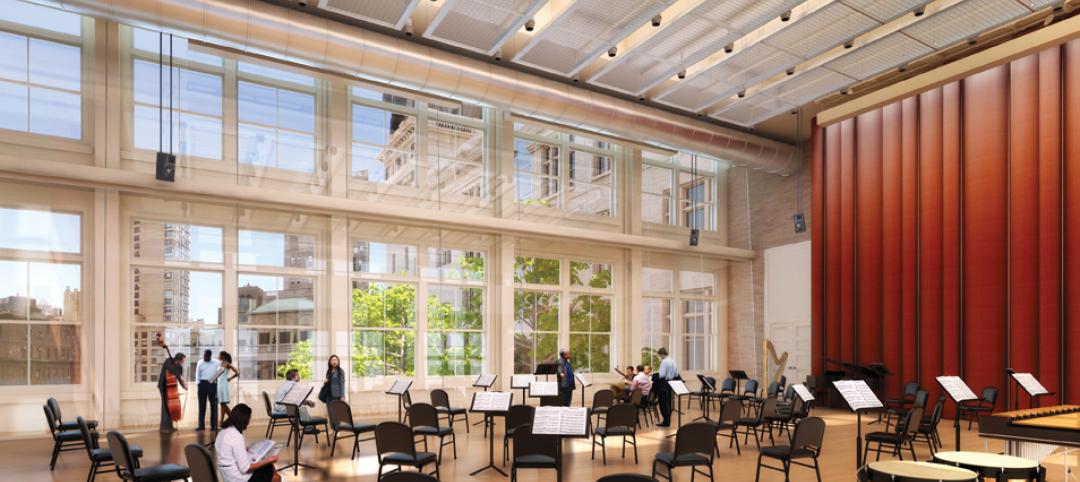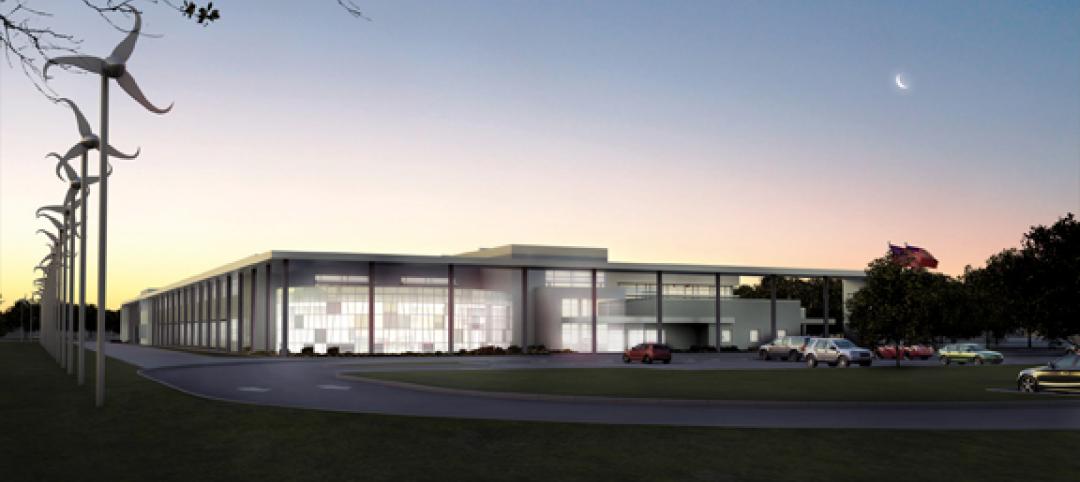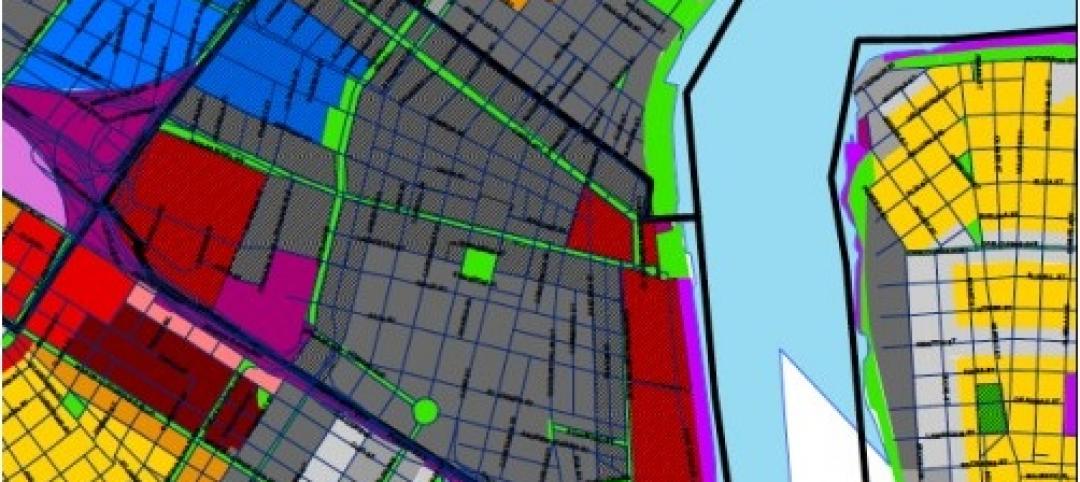Frei Otto has been named the 2015 Pritzker Architecture Prize recipient, Tom Pritzker announced this afternoon. The news comes a day after the visionary architect, 89, died in his native Germany.
Otto becomes the 40th laureate of the Pritzker Prize and the second laureate from Germany.
The Pritzker jury selected Otto as the laureate earlier this year, and shortly thereafter the Executive Director of the prize traveled to Otto’s home and studio in Warmbronn, Germany, to deliver the news in person. Learning that he had received the Pritzker Prize, Otto said: “I am now so happy to receive this Pritzker Prize and I thank the jury and the Pritzker family very much. I have never done anything to gain this prize. My architectural drive was to design new types of buildings to help poor people especially following natural disasters and catastrophes. So what shall be better for me than to win this prize? I will use whatever time is left to me to keep doing what I have been doing, which is to help humanity. You have here a happy man.”
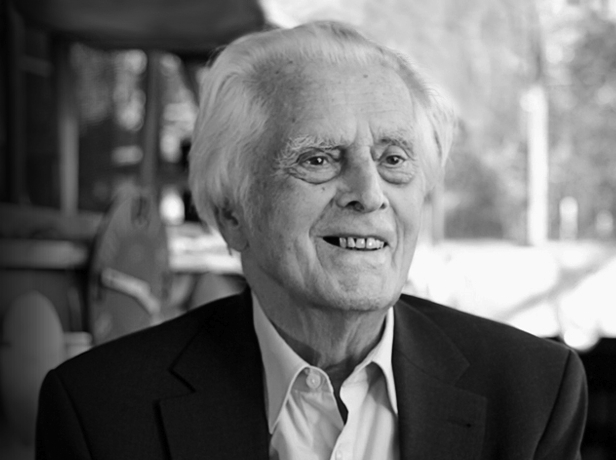 Frei Otto (1925-2015). Photo: Courtesy The Hyatt Foundation
Frei Otto (1925-2015). Photo: Courtesy The Hyatt Foundation
Otto practiced a holistic and collaborative approach to architecture, working with environmentalists, biologists, engineers, philosophers, historians, naturalists, artists, and other architects. A distinguished teacher and author, Otto pioneered the use of modern lightweight tent-like structures for many uses. He was attracted to them partly for their economical and ecological values. He believed in making efficient, responsible use of materials, and that architecture should make a minimal impact on the environment. Otto was a utopian who never stopped believing that architecture can make a better world for all.
In contrast to the heavy, columned, stone and masonry architecture preferred by the National Socialists in the Germany in which he grew up, Otto’s work was lightweight, open to nature and natural light, non-hierarchical, democratic, low-cost, energy-efficient, and sometimes designed to be temporary.
He is best known for the roofing for the main sports facilities in the Munich Olympic Park for the 1972 Summer Olympics (with Behnisch + Partner and others), for the German pavilion at the 1967 International and Universal Exposition (Expo 67), the Japan Pavilion at Expo 2000 in Hannover, Germany (in 2000, with Shigeru Ban, 2014 laureate of the Pritzker Architecture Prize), a series of tent structures for German Federal Exhibitions in the 1950’s, and for his work in the Middle East.
“Our jury was clear that, in their view, Frei Otto’s career is a model for generations of architects and his influence will continue to be felt,” said Tom Pritzker, Chairman and President of The Hyatt Foundation, which sponsors the prize. “The news of his passing is very sad, unprecedented in the history of the prize. We are grateful that the jury awarded him the prize while he was alive. Fortunately, after the jury decision, representatives of the prize traveled to Mr. Otto’s home and were able to meet with Mr. Otto to share the news with him. At this year’s Pritzker Prize award ceremony in Miami on May 15 we will celebrate his life and timeless work.”
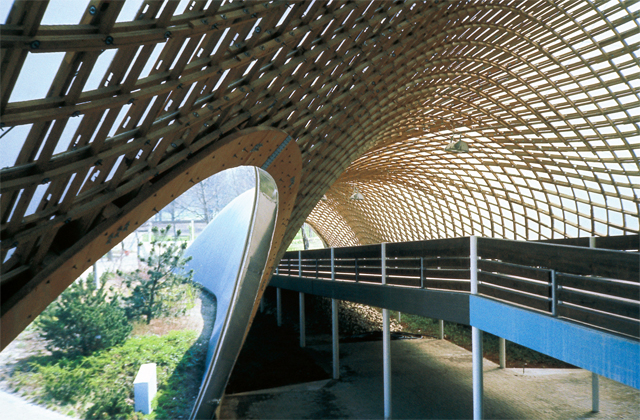 Roof for the Multihalle (multi-purpose hall) in Mannheim, 1970–1975, Mannheim, Germany. Photo © Atelier Frei Otto Warmbronn, courtesy The Hyatt Foundation
Roof for the Multihalle (multi-purpose hall) in Mannheim, 1970–1975, Mannheim, Germany. Photo © Atelier Frei Otto Warmbronn, courtesy The Hyatt Foundation
The Chair of the jury of the Pritzker Architecture Prize, Lord Peter Palumbo, said today: “Time waits for no man. If anyone doubts this aphorism, the death yesterday of Frei Otto, a titan of modern architecture, a few weeks short of his 90th birthday, and a few short weeks before his receipt of the Pritzker Architecture Prize in Miami in May, represents a sad and striking example of this truism. His loss will be felt wherever the art of architecture is practiced the world over, for he was a universal citizen; whilst his influence will continue to gather momentum by those who are aware of it, and equally, by those who are not.”
The Jury Citation
Frei Otto, born almost 90 years ago in Germany, has spent his long career researching, experimenting, and developing a most sensitive architecture that has influenced countless others throughout the world. The lessons of his pioneering work in the field of lightweight structures that are adaptable, changeable and carefully use limited resources are as relevant today as when they were first proposed over 60 years ago. He has embraced a definition of architect to include researcher, inventor, form-finder, engineer, builder, teacher, collaborator, environmentalist, humanist, and creator of memorable buildings and spaces.
He first became known for his tent structures used as temporary exhibition pavilions. The constructions at the German Federal Garden exhibitions and other festivals of the 1950s were functional, beautiful, “floating” roofs that seemed to effortlessly provide shelter, and then were easily dissembled after the events.
The cable net structure employed for the German Pavilion at Expo 67 in Montreal, prefabricated in Germany and assembled on site in a short period of time, was a highlight of the exhibition for its grace and originality. The impressive large-scale roofs designed for the Munich Olympics of 1972, combining lightness and strength, were a building challenge that many said could not be achieved. The architectural landscape for stadium, pool and public spaces, a result of the efforts of a large team, is still impressive today.
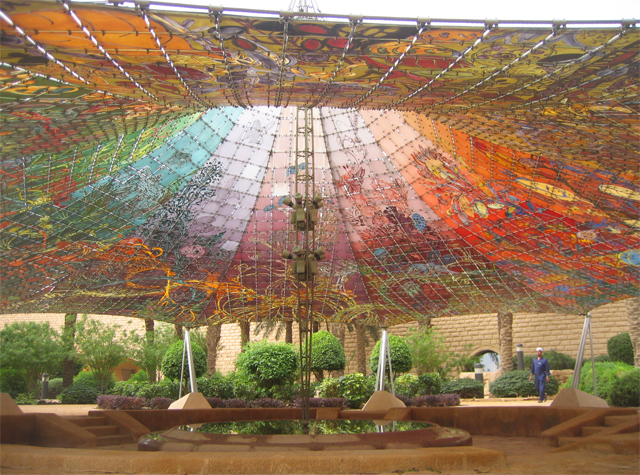 Diplomatic Club Heart Tent, 1980, Riyadh, Saudi Arabia. Photo © Atelier Frei Otto Warmbronn, courtesy The Hyatt Foundation
Diplomatic Club Heart Tent, 1980, Riyadh, Saudi Arabia. Photo © Atelier Frei Otto Warmbronn, courtesy The Hyatt Foundation
Taking inspiration from nature and the processes found there, he sought ways to use the least amount of materials and energy to enclose spaces. He practiced and advanced ideas of sustainability, even before the word was coined. He was inspired by natural phenomena – from birds’ skulls to soap bubbles and spiders’ webs. He spoke of the need to understand the “physical, biological and technical processes which give rise to objects.” Branching concepts from the 1960s optimized structures to support large flat roofs. A grid shell, such as seen in the Mannheim Multihalle of 1974, shows how a simple structural solution, easy to assemble, can create a most striking, flexible space. The Mechtenberg footbridges, with the use of humble slender rods and connecting nodes, but with advanced knowledge, produce an attractive filigree pattern and span distances up to 30 meters. Otto’s constructions are in harmony with nature and always seek to do more with less.
Virtually all the works that are associated with Frei Otto have been designed in collaboration with other professionals. He was often approached to form part of a team to tackle complex architectural and structural challenges. The inventive results attest to outstanding collective efforts of multidisciplinary teams.
Throughout his life, Frei Otto has produced imaginative, fresh, unprecedented spaces and constructions. He has also created knowledge. Herein resides his deep influence: not in forms to be copied, but through the paths that have been opened by his research and discoveries. His contributions to the field of architecture are not only skilled and talented, but also generous.
For his visionary ideas, inquiring mind, belief in freely sharing knowledge and inventions, his collaborative spirit and concern for the careful use of resources, the 2015 Pritzker Architecture Prize is awarded to Frei Otto.
Meet the Jury
The distinguished jury that selected the 2015 Pritzker Laureate consists of its chairman, Lord Palumbo, architectural patron, Chairman Emeritus of the Trustees, Serpentine Galleries, former Chairman of the Arts Council of Great Britain, and former Chairman of the Tate Gallery Foundation; Alejandro Aravena, architect and Executive Director of Elemental in Santiago, Chile; Stephen Breyer, U.S. Supreme Court Justice, Washington, D.C.; Yung Ho Chang, architect and educator, Beijing, The People’s Republic of China; Kristin Feireiss, architecture curator, writer, and editor, Berlin, Germany; Glenn Murcutt, architect and 2002 Pritzker Laureate, Sydney, Australia; Richard Rogers, architect and 2007 Pritzker Laureate, London, United Kingdom; Benedetta Tagliabue, architect and director of EMBT Miralles Tagliabue, Barcelona, Spain; and Ratan N. Tata, Chairman Emeritus of Tata Sons, the holding company of the Tata Group, Mumbai, India. Martha Thorne, Associate Dean for External Relations, IE School of Architecture & Design, Madrid, Spain, is the Executive Director of the Prize.
The 2015 award ceremony will be held in Miami Beach at the New World Center, designed by 1989 Pritzker Prize Laureate Frank Gehry, on May 15, 2015. This marks the first time the ceremony will be in Miami, joining the culturally and historically significant venues around the world. The ceremony will be streamed live on PritzkerPrize.com, the website of the Pritzker Architecture Prize.
About the Pritzker Architecture Prize
The Pritzker Architecture Prize was founded in 1979 by the late Jay A. Pritzker and his wife, Cindy. Its purpose is to honor annually a living architect whose built work demonstrates a combination of those qualities of talent, vision and excellence, which has produced consistent and significant contributions to humanity and the built environment through the art of architecture. The laureates receive a $100,000 grant and a bronze medallion.
Related Stories
| May 18, 2011
Carnegie Hall vaults into the 21st century with a $200 million renovation
Historic Carnegie Hall in New York City is in the midst of a major $200 million renovation that will bring the building up to contemporary standards, increase educational and backstage space, and target LEED Silver.
| May 17, 2011
Redesigning, redefining the grocery shopping experience
The traditional 40,000- to 60,000-sf grocery store is disappearing and much of the change is happening in the city. Urban infill sites and mixed-use projects offer grocers a rare opportunity to repackage themselves into smaller, more efficient, and more convenient retail outlets. And the AEC community will have a hand in developing how these facilities will look and operate.
| May 17, 2011
Architecture billings index fell in April, hurt by tight financing for projects
The architecture billings index, a leading indicator of U.S. construction activity, fell in April, hurt by tight financing for projects. The architecture billings index fell 2.9 points last month to 47.6, a level that indicates declining demand for architecture services, according to the American Institute of Architects.
| May 17, 2011
Sustainability tops the syllabus at net-zero energy school in Texas
Texas-based firm Corgan designed the 152,200-sf Lady Bird Johnson Middle School in Irving, Texas, with the goal of creating the largest net-zero educational facility in the nation, and the first in the state. The facility is expected to use 50% less energy than a standard school.
| May 17, 2011
Gilbane partners with Steel Orca on ultra-green data center
Gilbane, along with Crabtree, Rohrbaugh & Associates, has been selected to partner with Steel Orca to design and build a 300,000-sf data center in Bucks County, Pa., that will be powered entirely through renewable energy sources--gas, solar, fuel cells, wind and geo-thermal. Completion is scheduled for 2013.
| May 17, 2011
Should Washington, D.C., allow taller buildings?
Suggestions are being made that Washington revise its restrictions on building heights. Architect Roger Lewis, who raised the topic in the Washington Post a few weeks ago, argues for a modest relaxation of the height limits, and thinks that concerns about ruining the city’s aesthetics are unfounded.
| May 17, 2011
The New Orleans master plan
At an afternoon panel during last week's AIA National Conference in New Orleans, Goody Clancy Principal David Dixon and Manning Principal W. Raymond Manning shared their experiences creating the New Orleans Master Plan, a document that sets a new course for the city, from land use and transportation planning to environmental protection.
| May 17, 2011
Do these buildings look like buffalo to you?
It’s hard to contemplate winter now that we’re mid-spring, but when the seasons change, ice skaters in Winnipeg will be able to keep warm in plywood shelters designed by Patkau Architects. The designers created temporary shelters inspired by animal behavior—specifically, buffalo bracing against the wind. Check them out.
| May 16, 2011
USGBC and AIA unveil report for greening K-12 schools
The U.S. Green Building Council and the American Institute of Architects unveiled "Local Leaders in Sustainability: A Special Report from Sundance," which outlines a five-point national action plan that mayors and local leaders can use as a framework to develop and implement green schools initiatives.


